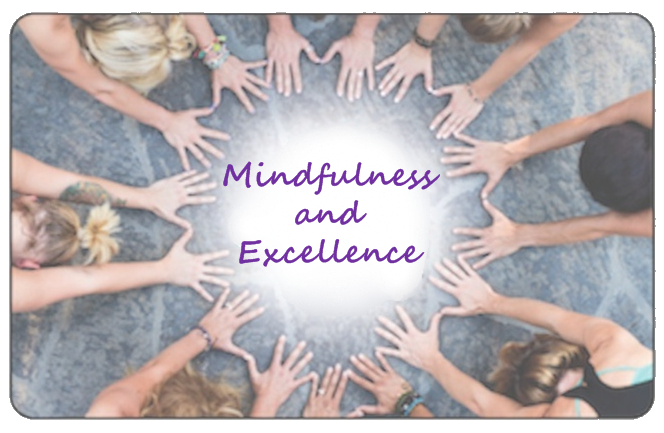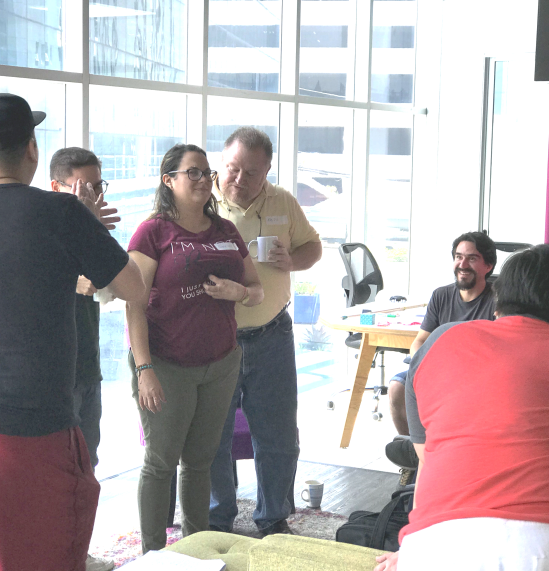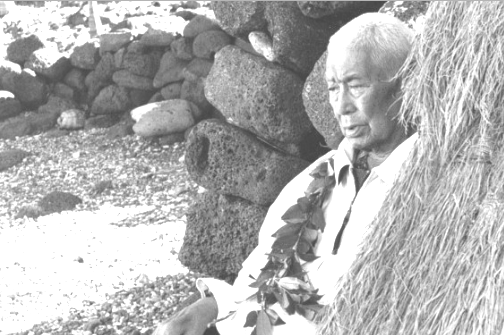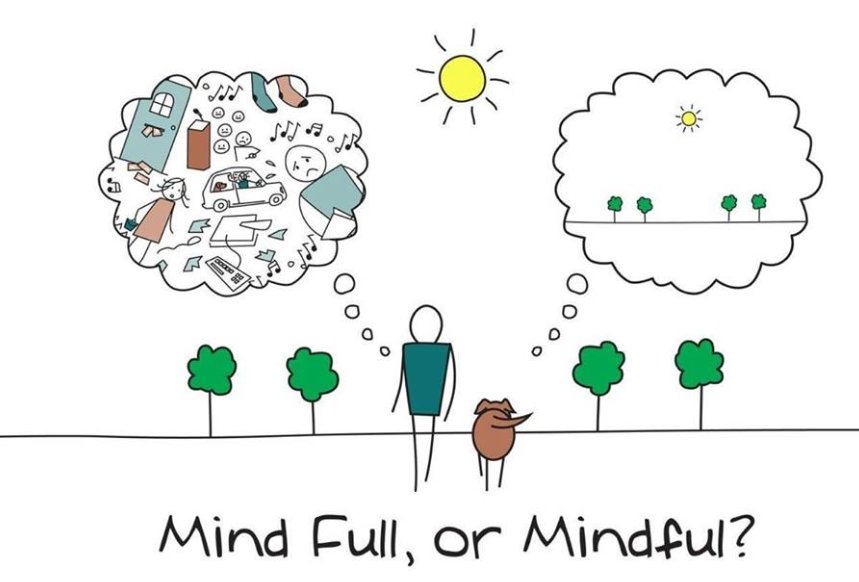When you think…
“Wow, I did a pretty good job on that,” how do you feel afterwards?
Or consider the thought, “You know, I’ve been pretty lucky.”— a warmth automatically spreads across your chest and shoulders and flows upward into your face as a little smile. We just can’t help it.
Thoughts Create Our (emotional) Reality
Thoughts, actions, and emotions all seem like different, independent phenomena, but they are automatically interrelated for us most of the time.
For example, if you have a negative thought like, “I just don’t think that I can do it,” suddenly you feel a lot smaller and less capable than you did before that idea came into your mind. You contract a little bit. But if you think, “At least I know that I have people who love me,” suddenly it causes a positive emotion to rise up in your body, you expand again, and feel able to move on to the next challenge.
If a coworker says something critical to you, a part of you interprets that thought and thinks, “That is not good, not what I want people saying about me.” Then you might feel angry You become more contracted in your body, and your shoulders drop and your posture slumps.
Feelings Also Constrain Thoughts
It works the other way too. Feelings lead to thoughts and behaviors, just a thoughts lead to feelings and behaviors.
If you are feeling angry, you tend to have angry thoughts. If you are feeling sad, you tend to have sad thoughts. If you are feeling happy then little negatives don’t affect you as much unless you take them in and begin to ruminate on them. Then it can change your mood, if you are not careful.
It has been said that,
People are just about as happy as they expect themselves to be.”
This is true. You have more effect on your own happiness than you probably realize you do.
Most of the time we think that our emotions just happen to us. We act like we have no control because we are not conscious of the thoughts that create them. And once we are in a particular mood, we tend to get stuck there for a while because our subsequent thoughts are constrained by our emotions. Happy thoughts don’t come to us when we are in a bad mood. Creative thoughts tend not to come to us when we are not curious.
But Behaviors Also Change Thoughts and Feelings
Now, if you study yourself carefully, you can see by observing your own experience that behaviors also come from thoughts and feelings. If you are angry or frustrated, (feelings) you are more likely to think negative thoughts and communicate in negative ways (behavior).
Changing our behavior also can change our thoughts and feelings. For example, when you are feeling sad or frustrated you might go for a walk or go to the gym. What happens then? Your new behaviors help you get out of the negative state of mind you were in and you come back feeling differently, thinking differently, and communicating differently.
This is why the old advice says,
Before you respond in anger, stop, take a deep breath, and count to 10.”
The breath and the mental behavior of counting begins to change your emotional state and gives you the space to reconsider how to better ask for what you want, rather than striking out with an angry communication.
So we can see that our emotions affect changes to thoughts and behaviors. Behaviors affect changes to thoughts and emotions. And thoughts affect our emotions leading to our behaviors. The body-mind is one big interrelated system where different subsystems mutually affect changes in one another.
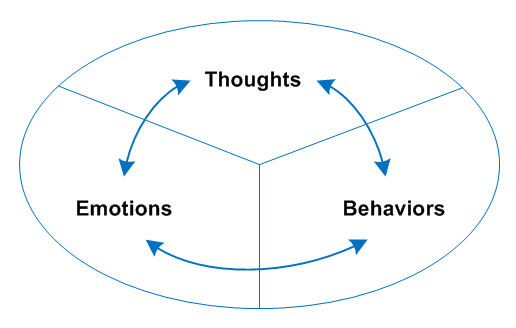
So What?
It is important to recognize the differences between our thoughts, emotions, and behaviors in order to grow ourselves and become the best human we can be. Otherwise we walk though life on automatic pilot not realizing the patterns of internal experience that create our circumstances. We suffer, but we don’t realize why we suffer and don’t know what to do about it.
We have to wake up to the causes of our suffering. By becoming aware of these structures inside ourselves and others, we can discover how other people create their suffering and how they create their excellence. We can copy the excellence, and grow ourselves in ways that we might never have thought about on our own. This is the essence of modeling our heroes and role models.
Every result we produce in the world, whether good or bad comes from our habitual patterns of emotions, thinking, and action.
The results you produce in the world are manifested from the structure of you internal sequences. The road to improvement starts with learning to clearly see your own patterns.
This is not a new idea, but a forgotten one.
Learner, Know Your Self,” and “To Thine Own Self Be True”
are ancient sayings that most people don’t fully understand today. All growth starts by knowing where we are coming from. Unfortunately it is not easy to really see ourselves clearly. It takes effort. So we must love our growth and desire to become better at who we are. If we love our mediocrity, if we accept being average, then there is no hope for us.
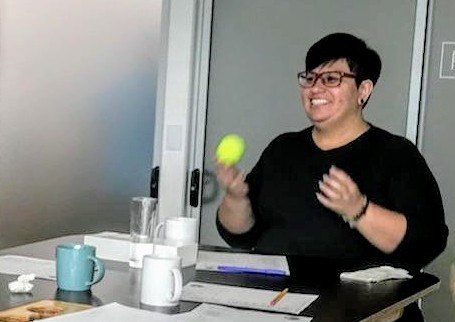
How We Create the Results We Get
Every result you have in your life comes from behaviors and communications that are based in these habitual sequences of thoughts, emotions, and actions. Whether you are achieving mediocre results in your life or excellent ones, the results you are getting come from the things you do, think, and feel. Whenever any result shows up over and over in our experience, whether good or bad, it is an indication that habitual patterns are at work creating that regular result. Experience has an underlying structure. Only when we do something novel, something different, something random, or something creative does a new result arise.
It is important to see these patterns so that we know what needs to change. Wisdom Game player, know thyself! The road to excellence starts with learning to see yourself and others more deeply. Discover your thoughts, emotions, and actions.
The Juggling Exercise
This past Saturday at The Weekly Wisdom Game we used juggling to help players learn to recognize and differentiate their thoughts, emotions, and behaviors by intuitive self observation. This exercise starts to balance and connect our conscious minds with our bigger, more pervasive, intuitive unconscious body-mind.
Players were asked to take a tennis ball and toss it from hand to hand in a continuous, rhythmic pattern. Tossing the ball back and forth and making the tosses graceful and regular takes some conscious concentration at first.
Then we asked the players to continue tossing the ball, but to look outward so that they were only watching their hands with their peripheral vision. It doesn’t take long for a graceful balance of body, mind, and emotion to develop when we put ourselves into a repeating pattern like this that challenges our consciousness and uses both sides of our brain. This is a “flow state” where we are at the edge of our current level of capability. At this point most people report that they “get into the flow” and feel a sort of pleasure at using their whole body-mind up to their challenge point.
Any time that we make a mistake, like dropping the ball, we reframe that as a learning by saying to ourselves “great learning” or by taking a bow and saying out loud, “Ta Da!” as if we meant to make that mistake. No behavior is really a mistake unless we don’t remember to stay relaxed, curious, and in learning mode. We refuse to let our body and emotions systems contract because we know every mistake leads to correction. By staying in this frame of mind, learning begins to occur automatically through our unconscious intuitive mind.
Once people could easily toss the ball in a regular pattern and feel the emotional flow-state take over their whole body, we practiced asking ourselves three questions to help us learn to self observe our mental, emotional, and behavioral patterns:
- What am I doing right now?— We wait to allow our intuitive minds to answer this question rather than our conscious-mind quick answer. Perhaps it says something like, “I am juggling,” or “I am tossing the ball from my left hand to my right hand,” or “I am standing here practicing.” Whatever arises from the intuitive mind is honored and respected without critique or judgment. We just notice.
- What am I feeling right now?— We wait to let our body respond, and we notice the emotions we are feeling. It might be curiosity, or joy, or frustration. Whatever we are feeling, we pay special attention to our body and try to notice where we are experiencing the center of that emotion. “Where is this emotion centered in my body?” “How big do I feel it?” and “Where are the boundaries?” “Is it radiating outward, or inward, or steady?” “How is it changing over time?”If we don’t feel like we are having an emotion right now, like we are simply neutral, we still feel into our body’s sensations and notice whatever we can about where the body is loose and relaxed and where it is tight. Elegance means only using the muscles we need and letting the others relax.
- What am I thinking right now?— We observe the thinking and storytelling part of our mind. “What thoughts come up?” “Making judgments about anything or anyone right now?” “Are we totally present to what we are doing or are we thinking about the past or the future right now?” We observe where our mind goes and how our thoughts are congruent or incongruent with our emotions and behaviors. We are developing the skill of just observing whatever is happening without judgment. We are building a part of ourselves that becomes a non-critical observer.
We encouraged the Wisdom Game Players to practice this self-observation juggling exercise at least once or twice per day and notice what they discover and what things change over the week while they do this practice.
As we get good at seeing our own behaviors, thoughts, and feelings, we begin to notice that they tend to come in habitual sequences that repeat and create our whole lives’ experience and the results we get in the world. This provides the magic information we need to be better at helping ourselves and others grow the sequences that make their lives better, and change the sequences that create negativity and suffering.
This is the start of truly being empowered and able to respond in better ways that improve our lives, and the lives of those in our family, work, and communities.
Let’s Play Together!
I hope that if you find this exercise interesting that you will join us next Saturday at Republic Space on the second floor of Edificio Sigma, Torre A at around 9:15 AM. We have camaraderie, coffee, cake, and a great time playing games that lead us to live better lives of Wisdom.
To Register and reserve your space at the Games: http://wisdomgamecr.com/
For more information, here is our Facebook Community Group: https://www.facebook.com/WisdomGameCR
